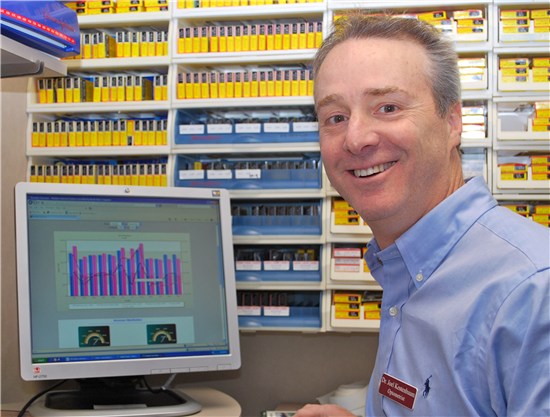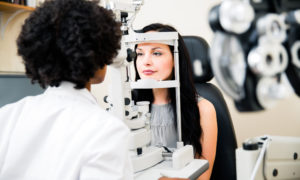By Joel Kestenbaum, OD
Business analysis tools elevate you to being a data analyzer of your practice–not just a data gatherer. Combine several business tools to make highly informed business decisions.
In analyzing your business, you need to understand where your money is coming from and going to. The best way to do that is to employ business tools that automate that task and allow you to rise above being a data gatherer to become an analyzer of data about your practice. When you combine several systems, as we do in our practice with QuickBooks, The EDGE and The Forensic Study from GPN, you have a powerful set of tools to make quick and sure management decisions with data-based confidence.

Joel Kestenbaum, OD, of Optix Family Eyecare Center in Plainview, NY, analyzes his practice’s financial performance using The Edge practice analysis tool.
Money Comes In…
Utilizing your practice management software, you can automatically collect data about where your money comes from. This includes:professional fees, contact lens materials, frames, spectacle lenses, nutraceuticals and more. Payments are collected from patients, insurance or vision plans.
Four years ago, our practice began using The EDGE, a practice analysis tool from GPN that works with OfficeMate. our practice management software (PMS). The EDGE imports data from our PMS and allows us to drill down so we can understand the relationships of how and why we generate revenue. This, in turn, lets us see where to focus our efforts.
Reviewing the numbers by themselves will not impact your business. You need to go deeper, and The EDGE does all the work for you.
Let’s take an example:In our office, like most optometric practices, we take many vision plans along with private pay. We also have more than one employee doing optical sales. The EDGE can sort out which employee works best with which vision plan, helping to maximize the patient benefits and the practice profits. And The EDGE does this with just one or two clicks of the mouse.
This analysis used to take us weeks to figure out (if we even bothered). And why is this important? When our doctors come out of the exam room with a patient using Vision Plan “A,” we know to give that patient to “Mary” because she knows how to maximize our profit and the patient benefit with that vision plan. And Mary can train others to do the same. QuickBooks may have revenue by type (frames, lenses, contacts and professional fees) but not by doctor, staff, plan or individual patient transaction. Therefore it produces just a top level number (a static number) that you don’t know how to impact. QuickBooks is a ledger system for bookkeeping. But combine itwith The EDGE, and you get a powerful trending analysis of the relationships that create the number–so you’re armed and ready to work with vision plans for maximum profit.
 …Money Goes Out
…Money Goes Out
On the opposite side, where is your money going? Do you know the costs of running both your professional practice and your optical separately as two uniquely different types of businesses? Systematically recording the data in a business accounting software, such as QuickBooks, is the first step to understanding your finances.You must set up a proper chart of accounts that does not clump together expenses and revenue but rather provides great detail of each. The next step is analyzing both your revenue and expense data using The Forensic Study, another business analysis tool from GPN.
The Forensic Study uses all the aggregate “cost of doing business data” you have in your QuickBooks, combines this with the breakdown of your optical and professional business income and shows you where you are making money or losing money. For many practices this will be an eye opener. You might think you are profitable on both sides of your practice, but many doctors are great in the medical end and poor in the optical (or vice versa). The Forensic Study will give you this analysis, and you will now be able to make an intelligent decision on the direction your practice has to take to be profitable on all sides.The Forensic Study goes beyond conventional accounting methods, in that it breaks data into the two areas of the practice: clinical and retail. Once data is isolated into these two areas, you can better understand where money is coming from and where it is going. Importantly, a static figure for a key practice metric (COG, cost per square foot) becomes actionable once you break out revenues and expenses in this manner, and The Forensic Study does this for you.
Setting Up Your Management System
The first thing I did is set up categories and subcategories in QuickBooks. Itemize fixed expenses such as rent, taxes, telephone, utilities, various insurance, and staff wages. In other words, what it costs me to open my door every Monday morning. Variable expenses include cost of goods, pension plan, 401K, auto expense and others.
I break down my cost of goods by frames, lenses, cases, solutions, nutraceuticals and other. Frames, lenses and contact lenses are further broken down by vendor so I can easily compare my profit margin for a particular vendor. Knowing the profit margin is extremely valuable when negotiating pricing.
Analyzing Frame Sales at a Glance
To analyze frames sales, I collected data from The EDGE from the first six months of 2013. I had sold 50 frames from Vendor A and collected a total of $3,000 (or an average of $60 per frame including third-party reimbursements). I also sold 50 frames for Vendor B with a total collection of $6,000. Because I itemized my payments to Vendor A and B in QuickBooks, I was able to take a glance in QuickBooks and see that my cost for Vendor A was $2,800 and $2,800 for Vendor B.
Making a Data-Based Decision
What should I do with this information? Should I be happy with a $200 profit for Vendor A, or should I order additional inventory from Vendor B, where my profit was $3,200? Maybe I should raise my frame fees on Vendor A products.The point is, I have information at my fingertips that allows me to better test the pulse of my business. The same information can be used to analyze lens and contact lens data.
Doing a Forensic Study
Next, I took the data from QuickBooks and entered it into GPN’s Forensic Study.
The Forensic Study looks at aggregate data. It does not ask me to break the cost of goods down by vendor. It does ask for total frame cost, lenses and contact lens costs, rent, employee compensation, and other fixed costs. It asks for the square footage of my optical and the clinic areas.
Using sophisticated calculations, this study shows me where my business is thriving and where it is lacking. I review the year- to-year comparisons to see where I have made improvements and where I’ve lost ground. The Forensic Study arms me with information to move forward in the proper management of my practice.
My advice is to use QuickBooks to its fullest, and use The EDGE along with The Forensic Study to gain invaluable insights from a business standpoint. Don’t just be a good doctor. Be a good business person, and you will build your practice with the confidence that you really know your numbers.
Related ROB Multimedia
Implementing Eyewear Measuring Technology
Understanding Your Cost of Goods and Measuring It Well
Joel Kestenbaum, OD, is founder and owner of Optix Family Eyecare Center in Plainview, NY. To contact him: jkoptix@gmail.com



























